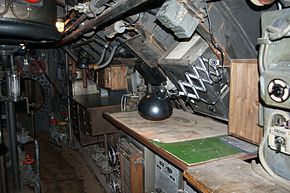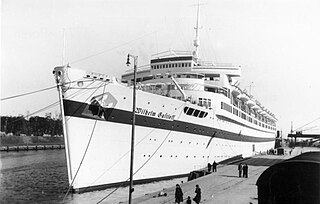
MV Wilhelm Gustloff was a German military transport ship which was sunk on 30 January 1945 by Soviet submarine S-13 in the Baltic Sea while evacuating civilians and military personnel from East Prussia and the German-occupied Baltic states, and German military personnel from Gotenhafen (Gdynia) as the Red Army advanced. By one estimate, 9,400 people died, making it the largest loss of life in a single ship sinking in history.

A submarine is a watercraft capable of independent operation underwater. It differs from a submersible, which has more limited underwater capability. The term is also sometimes used historically or colloquially to refer to remotely operated vehicles and robots, as well as medium-sized or smaller vessels, such as the midget submarine and the wet sub. Submarines are referred to as boats rather than ships irrespective of their size.
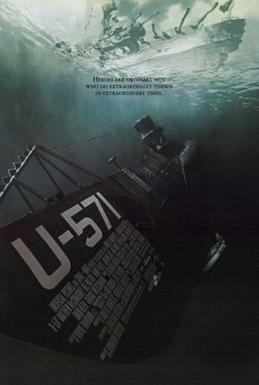
U-571 is a 2000 submarine film directed by Jonathan Mostow from a screenplay he co-wrote with Sam Montgomery and David Ayer. The film stars Matthew McConaughey, Harvey Keitel, Bill Paxton, Jon Bon Jovi, Jake Weber and Matthew Settle. The film follows a World War II German submarine boarded by American submariners to capture her Enigma cipher machine.
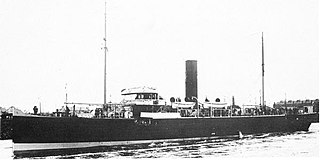
Q-ships, also known as Q-boats, decoy vessels, special service ships, or mystery ships, were heavily armed merchant ships with concealed weaponry, designed to lure submarines into making surface attacks. This gave Q-ships the chance to open fire and sink them. The use of Q-ships contributed to the abandonment of cruiser rules restricting attacks on unarmed merchant ships and to the shift to unrestricted submarine warfare in the 20th century.
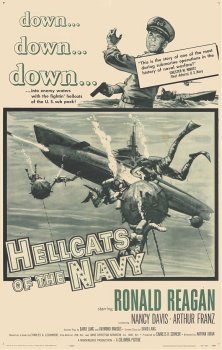
Hellcats of the Navy is a 1957 American black-and-white World War II submarine film drama from Columbia Pictures, produced by Charles H. Schneer and directed by Nathan Juran. The film stars Ronald Reagan and his wife, billed under her screen name Nancy Davis, and Arthur Franz. This was the only feature film in which the Reagans acted together, either before or after their 1952 marriage.

USS Nautilus (SSN-571) was the world's first operational nuclear-powered submarine and the first submarine to complete a submerged transit of the North Pole on 3 August 1958. Her initial commanding officer was Eugene "Dennis" Wilkinson, a widely respected naval officer who set the stage for many of the protocols of today's Nuclear Navy of the US, and who had a storied career during military service and afterwards.

USS Mackerel (SS-204), the lead ship of her class of submarines, was the first ship of the United States Navy named for the mackerel. Mackerel and her near-sister Marlin were prototype small submarines which the Navy was exploring to replace the aging S-class submarines.

Down Periscope is a 1996 American military comedy submarine film directed by David S. Ward, produced by Robert Lawrence, and starring Kelsey Grammer, Lauren Holly, and Rob Schneider along with Bruce Dern, Harry Dean Stanton, William H. Macy, and Rip Torn in supporting roles. Released by 20th Century Fox on March 1, 1996, the film focuses on Lieutenant Commander Thomas Dodge, a capable U.S. Navy officer who fights to save his career after being saddled with a group of misfit seamen who have been brought together as the crew of his first command, USS Stingray, a rusty, obsolete World War II-era diesel submarine that is the focus of a special naval war game, supervised by a bitter rival who is fighting to bury Dodge's career by any means necessary.

German submarine U-234 was a Type XB U-boat of Nazi Germany's Kriegsmarine during World War II, she was commanded by Kapitänleutnant Johann-Heinrich Fehler. Her first and only mission into enemy or contested territory consisted of the attempted delivery of uranium oxide and German advanced weapons technology to the Empire of Japan. After receiving Admiral Dönitz' order to surface and surrender and of Germany's unconditional surrender, the submarine's crew surrendered to the United States on 14 May 1945.

Operation Petticoat is a 1959 American World War II submarine comedy film in Eastmancolor from Universal-International, produced by Robert Arthur, directed by Blake Edwards, that stars Cary Grant and Tony Curtis.

The first USS Twiggs (DD–127) was a Wickes-class destroyer in the United States Navy during World War I. She was named for Major Levi Twiggs. She was later transferred to the Royal Navy, as HMS Leamington and to the Soviet Navy as Zhguchy, before returning to Britain to star in the film The Gift Horse, which depicts the St. Nazaire Raid.

The Enemy Below is a 1957 American DeLuxe Color war film in CinemaScope about a battle between an American destroyer escort and a German U-boat during World War II. Produced and directed by Dick Powell, the movie stars Robert Mitchum and Curt Jürgens as the American and German commanding officers, respectively. The film was based on the 1956 novel of the same name by Denys Rayner, a British naval officer involved in antisubmarine warfare throughout the Battle of the Atlantic.
German submarine U-219 was a Type XB submarine of Nazi Germany's Kriegsmarine during World War II. The U-boat was laid down on 31 May 1941 at the Germaniawerft yard at Kiel as yard number 625, launched on 6 October 1942, and commissioned on 12 December 1942 under the command of Korvettenkapitän Walter Burghagen.
Ghostboat is a 2006 British television film, based on a novel by George E. Simpson and Neal R. Burger. The film features David Jason as its star. It is a fantasy tale of His Majesty's Submarine Scorpion vanishing during the Second World War, leaving only one crew member surviving. 38 years later, in the Cold War year 1981, the Scorpion reappears; the crew have disappeared, but the vessel is otherwise unchanged and has not aged in the intervening years. A Royal Navy crew along with the sole survivor of the original voyage is given the mission of retracing the last days of the boat prior to her 1943 disappearance. A supernatural influence takes hold of most of the crew, and they start showing characteristics of the old crew. They find themselves fighting Second World War ghosts.

A deck gun is a type of naval artillery mounted on the deck of a submarine. Most submarine deck guns were open, with or without a shield; however, a few larger submarines placed these guns in a turret.

United States Navy operations during World War I began on April 6, 1917, after the formal declaration of war on the German Empire. The United States Navy focused on countering enemy U-boats in the Atlantic Ocean and the Mediterranean Sea while convoying men and supplies to France and Italy. Because of United States's late entry into the war, her capital ships never engaged the German fleet and few decisive submarine actions occurred.

Run Silent, Run Deep is a 1958 American black-and-white war film starring Clark Gable and Burt Lancaster, based on the 1955 novel of the same name by Commander Edward L. Beach Jr. The picture was directed by Robert Wise and produced by Harold Hecht. The title refers to "silent running", a submarine stealth tactic. The story describes World War II submarine warfare in the Pacific Ocean, and deals with themes of vengeance, endurance, courage, loyalty, and honor, and how these can be tested during wartime.
Hell Below is a TV series on The Smithsonian Channel produced by Parallax Film Productions Inc. The series is narrated by Canadian voice-over artist Mark Oliver, charting the stealth game of subsea warfare and the narrative from contact to attack of the greatest submarine patrols of World War II. Six initial episodes cover the rise of the Wolfpack to the drive for victory in the Pacific. Expert analysis and stock footage are woven with re-enactments filmed on authentic Second World War era submarines.
The Yanagi missions, or more formally the Submarine Missions to Germany, were a series of submarine voyages undertaken by the Imperial Japanese Navy (IJN) during the Second World War, to exchange technology, skills and materials with Japan's Axis partners, principally Nazi Germany. These voyages had to run the gauntlet of the Western Allies naval superiority in the Indian and Atlantic Oceans; of the five westbound voyages, three arrived safely, with two submarines sunk en route, while of the three successful vessels only one completed her return voyage, with two sunk before reaching home.
